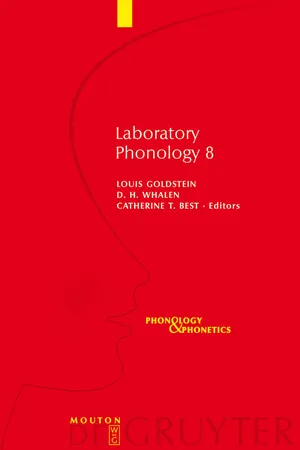
- 688 pages
- English
- PDF
- Available on iOS & Android
Laboratory Phonology 8
About this book
This collection of papers from Eighth Conference on Laboratory Phonology (held in New Haven, CT) explores what laboratory data that can tell us about the nature of speakers' phonological competence and how they acquire it, and outlines models of the human phonological capacity that can meet the challenge of formalizing that competence. The window on the phonological capacity is broadened by including, for the first time in the Laboratory Phonology series, work on signed languages and papers that explicitly compare signed and spoken phonologies.
A major focus, cutting across signed and spoken phonologies, is that phonological competence must include both qualitative (or categorical) and quantitative (or variable) knowledge. Theoretical approaches represented in the collection for accommodating these types of knowledge include modularity, dynamical grammars, and probabilistic grammars. A second major focus is on the acquisition of this knowledge. Here the papers pursue the consequences for acquisition of taking into account the richness and variability of the adult systems that provide input to the child. The final focus is on how phonological knowledge guides speech production. Data and models address the question of how speech gestures interact with one another locally (through articulatory constraints and syllable-level organization) and how they interact with the prosodic structure of an utterance.
The twenty-six papers in the collection include invited contributions from Diane Brentari, David Corina, David Perlmutter, D. Robert Ladd, Diamandis Gafos, Marilyn Vihman, Shelley Velleman, Stefanie Shattuck-Hufnagel, and Dani Byrd.
Frequently asked questions
- Essential is ideal for learners and professionals who enjoy exploring a wide range of subjects. Access the Essential Library with 800,000+ trusted titles and best-sellers across business, personal growth, and the humanities. Includes unlimited reading time and Standard Read Aloud voice.
- Complete: Perfect for advanced learners and researchers needing full, unrestricted access. Unlock 1.4M+ books across hundreds of subjects, including academic and specialized titles. The Complete Plan also includes advanced features like Premium Read Aloud and Research Assistant.
Please note we cannot support devices running on iOS 13 and Android 7 or earlier. Learn more about using the app.
Information
Table of contents
- Frontmatter
- Table of contents
- Introduction
- Dedication
- "Distinctive phones" in surface representation
- The functionality of incomplete neutralization in Dutch: The case of the past-tense formation
- Dynamics in grammar: Comment on Ladd and Ernestus & Baayen
- The statistical basis of an unnatural alternation
- Modeling intonation in English: A probabilistic approach to phonological competence
- The diachrony of labiality in Trique, and the functional relevance of gradience and variation
- Effects of language modality on word segmentation: An experimental study of phonological factors in a sign language
- Phonological, phonetics and the nondominant hand
- Lexical retrieval in American Sign Language production
- Phonological priming in British Sign Language
- Phonetic implementation and phonetic pre-specification in sign language phonology
- Variability in verbal agreement forms across four signed languages
- Some current claims about sign language phonetics, phonology, and experimental results
- Getting the rhytm right: A cross-linguistic study of segmental duration in babbling and first words
- Flexibility in the face incompatible English VOT systems
- On the scope of phonological learning: Issues arising from socially-structured variation
- Variation in developing phonologies: Comments on Vihman and colleagues, Docherty and colleagues, and Scobbie
- Prosody first or prosody last? Evidence from the phonetics of word-final /t/ in American English
- Focusing, prosodic phrasing, and hiatus resolution in Greek
- Early vs. late focus: Pitch-peak alignment in two dialects of Serbian and Croatian
- Manifestation of prosodic structure in articulatory variation: Evidence from lip kinematics in English
- Relating prosody and dynamic events: Coments on the papers by Cho and Smiljanić
- Syllable position effects and gestural organization: Articulatory evidence from Russia
- Perceptual salience and palatalization in Russian
- Integrating coarticulation, assimilation, and blending into a model of articulatory constraints
- Excrescent schwa and vowel laxing: Cross-linguistic: responses to conflicting articulatory targets
- Backmatter